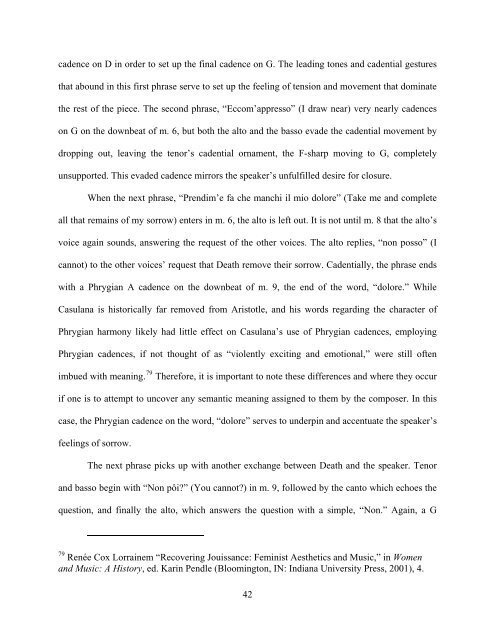Download - D-Scholarship@Pitt - University of Pittsburgh
Download - D-Scholarship@Pitt - University of Pittsburgh
Download - D-Scholarship@Pitt - University of Pittsburgh
Create successful ePaper yourself
Turn your PDF publications into a flip-book with our unique Google optimized e-Paper software.
cadence on D in order to set up the final cadence on G. The leading tones and cadential gestures<br />
that abound in this first phrase serve to set up the feeling <strong>of</strong> tension and movement that dominate<br />
the rest <strong>of</strong> the piece. The second phrase, “Eccom’appresso” (I draw near) very nearly cadences<br />
on G on the downbeat <strong>of</strong> m. 6, but both the alto and the basso evade the cadential movement by<br />
dropping out, leaving the tenor’s cadential ornament, the F-sharp moving to G, completely<br />
unsupported. This evaded cadence mirrors the speaker’s unfulfilled desire for closure.<br />
When the next phrase, “Prendim’e fa che manchi il mio dolore” (Take me and complete<br />
all that remains <strong>of</strong> my sorrow) enters in m. 6, the alto is left out. It is not until m. 8 that the alto’s<br />
voice again sounds, answering the request <strong>of</strong> the other voices. The alto replies, “non posso” (I<br />
cannot) to the other voices’ request that Death remove their sorrow. Cadentially, the phrase ends<br />
with a Phrygian A cadence on the downbeat <strong>of</strong> m. 9, the end <strong>of</strong> the word, “dolore.” While<br />
Casulana is historically far removed from Aristotle, and his words regarding the character <strong>of</strong><br />
Phrygian harmony likely had little effect on Casulana’s use <strong>of</strong> Phrygian cadences, employing<br />
Phrygian cadences, if not thought <strong>of</strong> as “violently exciting and emotional,” were still <strong>of</strong>ten<br />
imbued with meaning. 79 Therefore, it is important to note these differences and where they occur<br />
if one is to attempt to uncover any semantic meaning assigned to them by the composer. In this<br />
case, the Phrygian cadence on the word, “dolore” serves to underpin and accentuate the speaker’s<br />
feelings <strong>of</strong> sorrow.<br />
The next phrase picks up with another exchange between Death and the speaker. Tenor<br />
and basso begin with “Non pôi?” (You cannot?) in m. 9, followed by the canto which echoes the<br />
question, and finally the alto, which answers the question with a simple, “Non.” Again, a G<br />
79 Renée Cox Lorrainem “Recovering Jouissance: Feminist Aesthetics and Music,” in Women<br />
and Music: A History, ed. Karin Pendle (Bloomington, IN: Indiana <strong>University</strong> Press, 2001), 4.<br />
42















